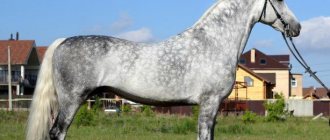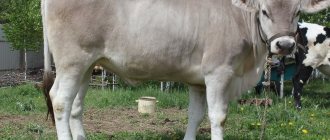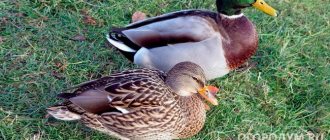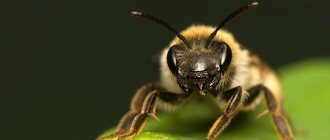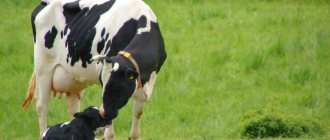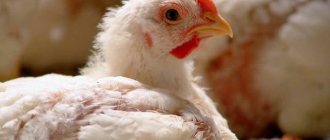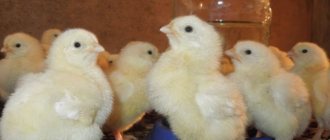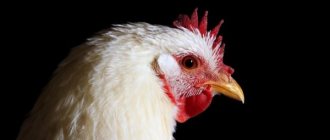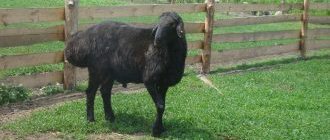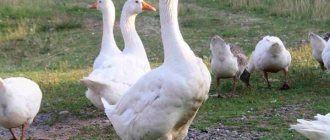The goose is a good supplier of meat, fat, down and feathers for its owner. At the same time, the large gray goose is very unpretentious in care. This breed belongs to the heavy meat-greasy group.
Over the years, more and more owners of farms and farmsteads have chosen the breed of large gray geese.
History of appearance. Borkovsky and Tambov subspecies
Large gray geese appeared from the crossing of Toulouse and Romain breeds. This happened in the 30s at the Ukrainian Poultry Research Institute. Because of the war, for the sake of preserving the resulting breed, they had to be transferred to the Arzhenka farm.
State farm specialists continued the work of their colleagues and worked to improve the breed. As a result of breeding several generations of birds, 2 ecotypes were obtained: Borkovsky and Tambov steppe geese.
All of them are called large grays, and only an expert can distinguish them by ecotype.
Character traits
A description of the breed would be incomplete without talking about the character of these birds.
Large gray geese are birds with a difficult character, vindictive and vindictive, but towards other bird species. So they are friendly with each other, live in a pack, obeying the leader. If a relative is in danger, others will rush to his aid. They communicate using screams and specific body movements.
Gray geese are able to become attached to the farmer and are ready to obey him. If they are not offended or irritated, then they will be peaceful and obedient.
Description of the breed
According to the standard, a representative of the large gray geese breed has:
- strong wide body;
- bulging muscles on the chest;
- a small, then strong head;
- medium length neck;
- noticeable fat fold on the abdomen ;
- thick orange beak with pink tip;
- strong and widely spaced orange paws ;
- dense massive wings;
- the feathers are gray on the upper part of the body and white on the lower part.
Geese have a more fragile and less powerful body. The main characteristics of the breed are presented in the table:
| Large gray geese | Body length, cm. | Weight, kg. | Average annual egg production, pcs. | Average egg weight, g. | Viability of masonry, % |
| Male | 37,7-37,0 | 6,5-7,0 | — | — | — |
| Female | 36,2-37,0 | 6,0 | 30-45 | 175 | 70-75 |
Feeding the goslings
Under maternal supervision, goslings do not need special care. The main thing is to follow the correct goose feeding regimen .
At first, these are mixtures of boiled eggs and herbs, cottage cheese and crushed corn or wheat, mixed with soybean or sunflower meal. After about a week, you can get used to root vegetables and cake. To prevent the nasal openings from becoming clogged, goslings should be given food in the form of wet, crumbly mash. When raising geese for meat, they are kept in a pen and fed concentrates with the addition of various greens. This makes it possible to achieve up to 4.5 live weight at the time of slaughter (9–10 weeks). In the first two months, goslings experience the most intensive growth. To gain 1 kg of live weight, a gosling needs 2–2.5 kg of grain and up to 9 kilograms of succulent feed.
In the future, maintenance does not make sense if you do not plan to create a goose family. Because the plumage will begin to change and stumps will appear on the carcass, as well as the growth rate will decrease and fat deposition will begin.
Nutrition
Attention! Fat must be added to the feed if geese are raised for meat or liver fattening.
Depending on the time of year and the purpose of raising geese, their nutrition is adjusted.
In the spring-summer season, the birds are on natural feeding with supplementary food. This means that in the warm season, the flock grazes in a meadow or in a special area previously sown with forage grass. The following are used as feed:
- root vegetables (pre-chopped);
- cake;
- bran;
- fish dust;
- legumes and cereals;
In the autumn-winter season, the diet is slightly different. Fresh grass from pastures is replaced with dry food. It comes in 2 main types: twig and grass. Root vegetables are also included in the diet, but in boiled form.
As in the summer season, soaked bran, legumes and cereal additives remain. Among the cereals for food, geese can eat barley, corn, oats and millet. Birds must consume vitamin mixtures, chalk and gravel.
Advice! For breakfast, geese should receive juicy food, and for dinner, mainly cereals
At any time of the year, the flock should have enough fresh drinking water . As a healthy addition to the diet, you can use fresh or dry duckweed, salt, yeast and meat and bone meal.
As for feeding geese in industrial conditions, modern poultry farming uses dry food. This diet is balanced and contains all the necessary elements. Specific norms of food consumption per individual are shown in the table:
| Age | Dry food, g. | Combined feeding | |
| concentrated feed, g. | succulent food and greens, | ||
| Adult | 330 | 220 | 500 |
| Goslings aged, days | |||
| 1-5 | 35 | 18 | 30 |
| 6-10 | 90 | 40 | 50 |
| 11-20 | 110 | 50 | 100 |
| 21-30 | 220 | 12 | 20 |
| 31-40 | 280 | 140 | 300 |
| 41-50 | 328 | 160 | 400 |
| 51-60 | 338 | 180 | from 500 or more |
| Replacement goslings aged, days | |||
| 60-240 | 260 | 180 | no limits |
If the farm is small, then it would be advisable to use a combined feeding method . This means that the geese receive both grain (concentrated) feed and succulent feed.
Goslings are raised either for meat or to replenish the parent flock (such individuals are called replacements). Feeding goslings is especially important.
In the first 7 days after hatching, they should consume a mixture consisting of corn, wheat, cottage cheese, finely chopped eggs and sunflower or soybean meal.
Boiled root vegetables and a wet mixture of cake are introduced from the 8th day of life of the young animals. Further, as the individual grows, grain feed is gradually introduced. This happens when the goslings are already a little stronger and can eat dry food without the risk of suffocation.
Possible diseases
Geese, unlike other poultry, are quite often exposed to various ailments. Among the non-communicable diseases they are most often diagnosed with:
- Avitaminosis. With its development, growth slows down, fertility decreases, the feeling of hunger disappears, the level of egg production decreases, and the younger generation dies.
- Rickets. Develops with a lack of vitamin D, lack of sunbathing, and poor nutrition. It is manifested by growth retardation, thin shells of eggs, and softening of the beak.
- Cloacite. Inflammation of the cloaca occurs due to a lack of vitamins A, E, D. As a result, the cloaca bulges and bleeds.
- Cannibalism. Occurs when the goose barn is overcrowded, poor lighting, lack of protein in the feed, incorrect humidity parameters, and poor ventilation in the room.
- Blockage of the esophagus. This disruption of the digestive system occurs due to improper feeding (in particular, eating only dry food and insufficient fluid intake).
- Enteritis. Occurs due to poor quality nutrition and the intake of contaminated water into the body.
Keeping large gray geese
Note! If an individual is constantly cold, then it consumes more food in an attempt to warm up. This means that the cost of maintaining geese will increase.
It is not difficult to create favorable conditions for this breed. The poultry house should be built either from wood or a combination of clay and concrete.
The floor should be 20-30 centimeters above ground level. This is provided in order to avoid dampness in the room. Excess moisture is dangerous for geese, as it reduces the individual’s self-heating.
There should be no drafts in the poultry house, and the structure itself should be dry. Representatives of the breed of large gray geese are cold-resistant. Good bedding will help them survive the drop in temperature safely.
In winter, it consists of peat and straw (superphosphate can be added to it to improve thermal qualities at the rate of 200 grams per 1 square meter ).
As a result of this mixing, good fertilizer is obtained from straw. In the summer, it is enough to use sawdust with sand for bedding. Any type of litter is prepared according to one formula.
One adult bird accounts for 40 kg . 7 kg are consumed per caterpillar .
Carefully! Birds should not be walked near a dirty pond or in strong sun at midday. Violation of these rules will result in deterioration in the health of the geese.
This breed is also good because its representatives are able to find their way home on their own , provided they are walked a short distance from home.
It is imperative that in the room where the bird is kept there must be nesting places, feeders and drinking bowls. These are mandatory attributes for keeping geese.
The nesting site can be made of straw and sides made of cardboard or wood. Feeders and drinkers should have an elongated shape and a small height.
Varieties
At the moment there are 3 subspecies of this breed:
- Ural;
- Ukrainian;
- Tambov
Ural (or Shadrinsky)
The subspecies began to take shape in the 17th century on the territory of Russia in the Kurgan region. To breed it, representatives of several breeds with the most stable characteristics were crossed with representatives of the wild geese breed. The subspecies finally took shape only in the 20th century. The term “gray Ural goose” covers representatives of the checkerboard, white and gray varieties. Gray Ural geese have become widespread in the Ural Mountains and Siberia. They differ from Ukrainian geese by a shorter neck, narrow tail and slight changes in the color of the plumage.
In weight, males reach a mass of 6.5 kg. And geese are about 5 kg. Hatchability indicators coincide with the Ukrainian breed of geese.
Ukrainian (or Borkovsky)
The subspecies was bred on the territory of Ukraine. The entire process of breeding individuals with the desired characteristics took about three years. During this time, female individuals of the Toulouse breed were crossed with male individuals of the Romny breed. The first three generations of geese were crossed. After three years of breeding work, the breed began to develop “in itself.” The main characteristics for this subspecies are given above.
Tambov (or steppe)
Work on breeding the subspecies began in the 40s of the 20th century. It was during the occupation of the territory of Ukraine that researchers were taken from there, and the result of their work was breeding geese. A new research base was equipped in the Tambov region on the territory of the Ardzhenka state farm. In order to obtain this subspecies, individuals of the Toulouse and Romny breeds were crossed only once, after which individuals of Tambov geese were bred “inside”
Particular attention was paid to the ability of birds to survive for a long time without bodies of water. For this purpose, young geese were raised on pastures, almost not allowed into water bodies
Proper breeding of large greylag geese
One of the advantages of this breed is that geese cope well with the role of mothers. They incubate eggs for approximately 28-30 days . And with proper care and quality nutrition, they are able to increase their brood to 15 goslings .
Note! The correct ratio of ganders and geese is the key to large offspring. For 1 male there should be 2-3 females.
At the end of winter, it is necessary to add more protein to the gander's diet . At this time of year, they prepare for fertilization, and protein helps improve their reproductive function.
Between 7 and 11 months of age, ganders reach sexual maturity . Its peak usually occurs at the age of 3-4 years . Geese of this breed protect their offspring well.
Productivity: eggs, meat, liver
Large gray geese are bred for their liver and meat. When slaughtered, one bird produces 4-6 kilograms of goose meat. This breed of birds has, although not a record-breaking, but good potential for liver growth. Its weight with the right diet can reach 350-450 grams.
The egg production of this breed is average. The goose produces 30-40 eggs per year. But with good care, this figure increases to 60, and according to some sources, up to 70 pieces. Brood viability is 60%.
Gray goose down is also valuable. It is light, warm and stretchy. It can be used to fill blankets or pillows, or for spinning. Things knitted from such material will be distinguished by high wearability, as well as remarkable warming properties.
From one bird throughout its life, on average, up to 4 kilograms of a mixture of down and feathers are obtained.
Where to buy geese
Birds of the large gray breed are very popular, so purchasing them is not a problem. This can be done at one of the following nurseries.
| Name | Contact details |
| "Poultry yard" | Ukraine Online store https://keklik.com.ua/ 067-9183494, 095-1290482, 093-5648787 |
| "Goose Farm" | Moscow region, Chekhov district, Alferovo village. Tel. 8-965-178-38-71; 8-916-751-91-07; 8-929-654-43-65. https://goose-farm.rf/ |
| Nursery "Sibiryak" | Krasnoyarsk, 21 km. Yenisei highway, opposite the village. Roadside. Tel., 8-960-761-19-15. https://www.krasfermer.ru/ |
| Nursery of elite birds "Golden Pheasant" | Tula region, p. High> 8-962-276-71-11; 8-910-701-11-46; https://goldfaz.ru/ |
| "Nursery for breeding agricultural poultry" | Moscow “Gardener” (“Bird Market”), 14 km. MKAD (Belaya Dacha) 8(495)941-90-84;; 8-926-586-42-004 8-925-772-67-32. |
| "Blagovarsky Poultry Plant" | Republic of Bashkortostan, Blagovarsky district, village. Linguistically (34747) 2-19-8944; (34747) 2-19-98. https://blag-duck.ru |
Reviews from owners
Natalia . Beautiful birds. I thought for a long time about which geese to choose and chose gray ones. I didn't make a mistake. It is interesting to keep and profitable for meat.
Eugene . This is not the first year I have been growing gray ones. They have proven themselves “5” - they grow quickly and do not create problems.
Svetlana . While they were little, I babysat them like children. Now they are running around after me. Very hardy. If emotions harden, they take wing funny. They can persistently stand near an outdoor table in the area and demand treats, tugging on sleeves and pants legs. Like dogs in their attachment to their owner.
Price
The price varies depending on what you buy: hatching eggs, young animals or adults. The price will vary at different nurseries. Average price indicators are presented in the table:
| Type, 1 pc. | price, rub. |
| Hatching egg | from 100 |
| Young animals (day old) | from 160 |
| Adult | from 800 |
Pay attention to other popular breeds:
Broilers, Tula and Landish geese.
Preparing for cold weather
In order for geese to continue laying eggs in the winter and not to deteriorate the quality of the meat, they need comfortable living conditions, as well as a balanced diet.
In winter, gray birds eat a lot; more food needs to be prepared. One adult eats during the winter:
- hay (clover, alfalfa) - 15 kg;
- root vegetables (mainly carrots) - 45 kg;
Caring owners dry birch and aspen branches. The leaves are crushed and added to mixed feed porridge.
The branches are steamed in water and hung so that the bird can pluck the leaves.
Duckweed from the pond is an excellent winter nutrient supplement. It is prepared in the summer - dried.
Record holders
Geese themselves are considered one of the heaviest poultry. But even among them, not all have the same mass. Of all the heavyweights, the leaders are considered to be Toulouse, which reach up to 16 kg, Kholmogory, and Mamut. The varieties belong to the meat category; goslings can be raised as broilers. By 4 months, goslings of many breeds, which are recognized as the best in the world, on a standard diet without any problems gain a weight of 5 kg.
The advantages of the breed include not only a large body and the speed of gaining muscle mass, but also resistance to external factors and good health. Of course, the egg production of heavyweights is low, but this is how it should be, because the energy of the feed is spent on creating mass. But geese of some breeds can lay eggs relatively well, so the eggs obtained from them are enough for home use.
The poultry business is considered profitable; provided that the goose farm is properly fed with inexpensive feed and the maintenance rules are followed, it can generate significant profits.
Large breeds of geese are distinguished by the fact that they grow quickly, have a large body, and have a high slaughter yield of meat. The varieties are ideally suited for growing for meat, both for personal consumption and for making a profit from meat breeding of geese. It is especially effective to raise birds as broilers; by the age of 4-5 months they produce carcasses, the profitability of which is the lowest. The meat is not fatty, tasty, and you can get the product by feeding the bird with regular feed or mixed feed.
How to raise chicks with a hen?
It is believed that raising chicks from an egg with a hen is more correct and better than raising birds in an incubator. But if there is only one hen on the farm, she can hatch a maximum of 13-14 birds due to the large size of the eggs. If you give preference to this particular method, first they create conditions.
What rules to follow:
The room temperature should be 14-15 degrees. The house must be dry
It is important to ventilate the room, but make sure there are no drafts. Set up a nest for the goose so that it is spacious
It is separated from other livestock and fenced off with partitions. The hens are kept separately from the rest of the geese, since the geese, during the absence of the expectant mother, can lay eggs into an already hatched clutch. Because of this, the period of receiving goslings will be significantly delayed, which may have a bad effect on the further development of the chicks.
The nest should be dry and clean. If an egg accidentally breaks, immediately remove it and wipe off all the remaining ones. Partitions between nests are important - this way the hens will not roll other people's eggs towards themselves, because geese have a strong maternal instinct. Due to the excess number of eggs in one nest, the goose simply will not be able to heat them all at once, and there is also a risk that they may be damaged. When the hens return to their nests, each of them should take its place without confusing them. During incubation, change the water in the expectant mother's drinking bowl daily - this will prevent her from diarrhea. The geese are fed selected grain. Next, the hen will take care of all the brooding processes on her own.
The first chicks appear on the 28th day. After this, they are taken from the nests and placed in a separate box, illuminated with a lamp, creating the necessary temperature regime. After all the chicks appear, they are returned to the goose. In the first 48 hours, you can give the mother goose several chicks from eggs that were hatched in an incubator. It's better to do this in the evening.
